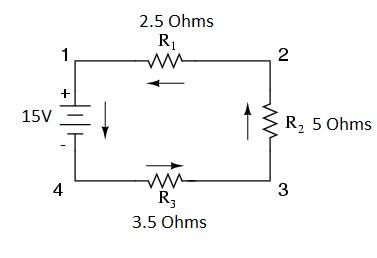Series And Parallel Circuits

.
Questions and Answers
- 1.
Is this an example of a Series or Parallel circuit?
- A.
Series Circuit
- B.
Parallel circuit
- C.
Combination circuit
- D.
Neither Parallel nor Series
Correct Answer
B. Parallel circuitExplanation
This is an example of a parallel circuit because in a parallel circuit, the components are connected in such a way that there are multiple pathways for the current to flow. In this case, the components are connected in parallel, allowing the current to divide and flow through each component separately.Rate this question:
-
- 2.
In the circuit shown the Total Resistance is calculated as:
- A.
0.016 Ohms
- B.
1300 Ohms
- C.
625 Ohms
- D.
100 Ohms
Correct Answer
C. 625 OhmsExplanation
The total resistance in a circuit is calculated by adding up the resistances in parallel.
1/R = 1/10 + 1/2 + 1/1 = 16/10
R = 10/16 = 0.625 kilo ohms = 625 ohmsRate this question:
-
- 3.
Is this a Series, Parallel or Combination circuit?
- A.
Series
- B.
Parallel
- C.
Combination
- D.
Cannot be Determined
Correct Answer
A. SeriesExplanation
The given answer is "Series" because in a series circuit, the components are connected one after another, creating a single path for the current to flow. In this type of circuit, the current remains the same throughout, while the voltage is divided among the components.Rate this question:
-
- 4.
In the circuit shown what is the total resistance?
- A.
0.0909 Ohms
- B.
11 Ohms
- C.
3 Ohms
- D.
1.36 Ohms
Correct Answer
B. 11 Ohms -
- 5.
In the circuit shown the total resistance (to the nearest Ohm) is:
- A.
900 Ohms
- B.
186.72 Ohms
- C.
199 Ohms
- D.
194.55 Ohms
Correct Answer
C. 199 OhmsExplanation
To find the total resistance, we need to analyze the series and parallel combinations of resistors in the circuit:
Identify Series Resistances:
R1 and R2 are in series: R1 + R2 = 100 Ω + 250 Ω = 350 Ω
R3 and R4 are in series: R3 + R4 = 350 Ω + 200 Ω = 550 Ω
Identify Parallel Resistances:
The combined resistance of (R1 and R2) is in parallel with the combined resistance of (R3 and R4).
Calculate Parallel Resistance:
Let Rp be the total resistance of the parallel combination.
1/Rp = 1/350 Ω + 1/550 Ω
1/Rp = 0.00514
Rp = 194.55 ΩRate this question:
-
Quiz Review Timeline +
Our quizzes are rigorously reviewed, monitored and continuously updated by our expert board to maintain accuracy, relevance, and timeliness.
-
Current Version
-
Sep 25, 2024Quiz Edited by
ProProfs Editorial Team -
Mar 09, 2020Quiz Created by
CB







